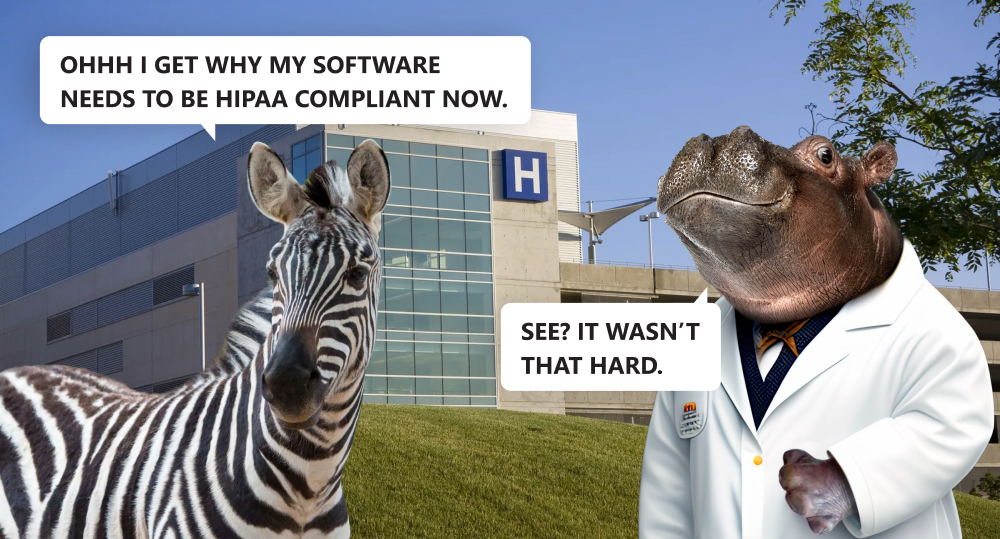Have you heard about the Health Insurance Portability and Accountability Act (HIPAA)? If you're a software development company who deals with medical records, we sure hope you've heard of it! After all, it's been around since 1996 working hard to protect our sensitive data from anyone who might want to mishandle or misappropriate it. In this article, we've outlined everything you need to know about HIPAA, including why it's so important, and even a HIPAA compliance checklist for software development.
So read on to get in the know about HIPAA and how custom healthcare software can improve your health information technology.
written by:
Anton Rykov
Product Manager
Contents
What Is HIPAA?
The Health Insurance Portability and Accountability Act of 1996 (HIPAA) is a federal law that mandated the establishment of national regulations to prevent sensitive medical data about patients from being revealed without the patient's knowledge or permission. To enforce HIPAA standards, the US Department of Health and Human Services (HHS) published the HIPAA Privacy Rule. The HIPAA Security Rule safeguards a portion of the data protected under the Privacy Rule.
To be compliant, healthcare organizations must incorporate HIPAA regulations within existing operations to maintain the security, confidentiality, and validity of protected health information (PHI) through a network of interconnected legal requirements.
PHI — What’s That?
PHI refers to any demographic characteristics that may be accessed to identify a patient or consumer of a HIPAA-compliant entity. Identities, residences, contact information, Social Security numbers, medical data, payment data, and full face pictures are all instances of PHI.
PHI transferred, saved, or obtained electronically is likewise subject to HIPAA regulations and is referred to as electronic protected health information, or ePHI. The HIPAA Security Rule governs ePHI, which was added to the HIPAA regulations to accommodate developments in medical technologies.
Who Is Required to Be HIPAA-Compliant?
Despite what many may believe, it's not just your average healthcare providers and institutions that need to follow this law. The HIPAA clinical health act regulations distinguish between two categories of enterprises that must be HIPAA-compliant.
Covered Entities: According to HIPAA regulations, a covered entity is any organization that receives, generates, or distributes PHI electronically. Covered entities in the healthcare industry include health care providers, health insurance providers, and health care intermediaries.
Business Associates: As indicated by HIPAA standards, a business associate is any company that comes into contact with PHI in any manner while performing services in place of a covered entity. Due to the vast range of service providers that may manage, transmit, or input PHI, there are several kinds of business associates. Billing businesses, practice management organizations, third-party advisors, EHR providers, MSPs, IT services, faxing businesses, and shredder companies are notable examples of business partners impacted by HIPAA laws.
HIPAA-Compliant Software
Now that we've established what HIPAA compliance and PHI are, as well as who should be involved, let's take a look at HIPAA-compliant software. However, before delving into the specifics of this medical software, let us first address one essential point. Contrary to popular belief, there is no such thing as HIPAA-compliant software. This only generally refers to software that has been modified to make you, your coworkers, and your firm HIPAA-compliant.
To simplify what we mean, take for instance a HIPAA-compliant chatbot. It applies to services used for health-care organizations to establish secure patient messaging and interaction with medical and nonmedical workers while avoiding the danger of sensitive patient data being exposed.
With that out of the way, let's get into HIPAA compliance. HIPAA-compliant software adheres to all its rules for the secured processing of patients' PHI. The objective of HIPAA compliance software is to offer a structure that assists a covered entity or business associate through the journey of becoming HIPAA-compliant and maintaining ongoing observance with its regulations.
Why is building HIPAA-compliant software so important? It's because we as humans make mistakes without perhaps even realizing it. In fact, according to a study by Tessian, human errors are responsible for 85% of data breaches.
HIPAA Compliance Rules
HIPAA-compliant development methods are established by a set of legislative laws and rules that outline the requirements necessary for secure operations with electronic PHI, as well as basic standards for HIPAA-compliant software development. Let’s go over these mandatory rules, before we get into the checklist for your software:
1. HIPAA Privacy Rule
This regulation establishes national guidelines for a patients' access to PHI. The HIPAA Privacy Rule is exclusive to covered entities; whereas it does not apply to business partners. This rule specifies several requirements, including patients' abilities to view PHI, health care providers' powers to limit access to PHI, the components of Use and Disclosure HIPAA release forms and Notices of Privacy Practices, among others. The proper policies must be established in the HIPAA Policies and Procedures of the business. All personnel must be instructed on these Policies and Procedures on a yearly basis, with documentation provided.
2. HIPAA Security Rule
This regulation establishes national standards for the safe storage, transfer, and management of ePHI. Because of the possible exchange of ePHI, the HIPAA Security Rule extends towards both covered entities and business associates. The Security Rule establishes criteria for the security and confidentiality of ePHI, including structural, organizational, and technical measures that need to take effect in every health care institution. The regulation's details must be specified in the organization's HIPAA Policies and Procedures. Employees must be instructed on these Policies and Procedures on a yearly basis, with documentation.
3. HIPAA Enforcement Rule
The HIPAA Enforcement Regulation outlines the requirements for data breach investigations and massive fines. The fine amount, though, fluctuates depending on the amount of medical records compromised and the degree of information breaches in a business. A first-time breach can result in a company spending anywhere from $100 to $50,000, while consecutive breaches can cost up to $1.5 million.
4. HIPAA Breach Notification Rule
The HIPAA breach notification rule is a series of guidelines that covered entities and business associates must implement in the case of a data breach involving PHI or ePHI. It specifies varying rules for breach reporting based on the extent and severity of the incident. Companies must disclose all breaches, irrespective of magnitude, to HHS OCR; however, the particular reporting methods vary based on the nature of the breach. If the data breach affects fewer than 500 people, the firm must notify all impacted persons within 60 days of the breach's detection. The employer also must notify the US Department of Health and Human Services' Office for Civil Rights within 60 days after the beginning of the next calendar year. Whenever a data breach affects more than 500 people, the company is required to inform the media as well.
5. HIPAA Omnibus Rule
The HIPAA Omnibus Rule is an extension to the HIPAA regulations that was created to implement HIPAA to business partners as well as covered companies. This regulation requires business associates to be HIPAA-compliant and sets the standards for Business Associate Agreements (BAAs). Well before PHI or ePHI may be transmitted or exchanged, a covered entity and a business associate — or two business associates — must sign a Business Associate Agreement. The Omnibus Regulation was introduced in January 2013 and reinforces the previously specified standards.
HIPAA Compliance Checklist for Software Development
The safeguarding of patient data is addressed under a number of HIPAA regulations. They contain detailed instructions for confidentiality and reporting data breaches. You must configure your program in a way that complies with HIPAA regulations.
The following is a checklist to ensure HIPAA-compliant software development:
1. User Authorization
The US government divides the identification security into four distinct levels, showcasing a comprehensive approach to safeguarding digital assets. At the basic levels, reliance on a singular authentication element meets the encryption standard. However, as we ascend to more advanced levels, the adoption of multifactor verification becomes vital, making users verify their cell phones and email accounts. If you want to enjoy HIPPA-compliant software, take advantage of at least two of the following aspects:
- Expertise: A user is required to provide a particular set of data, which is only known to the legitimate user, i.e., a password, PIN, or security question.
- Ownership: The platform provides users with extra information, such as a pass code. As a result, the visitor must input specific information in order to secure legal custody of the data.
- Inherence: A biometric scanner is utilized to validate a user's intrinsic feature that cannot be replicated or altered.
2. Resolution Strategy
The remediation plan is a security strategy that specifies the steps done by business associates to secure patient information. As a result, it details industry standards in security, covering the following factors:
- A HIPAA software compliance checklist of all the actions that will be completed in order to maintain data confidentiality.
- Every single member's duty is clearly identified through a pre-approved plan.
- Initiatives for overcoming future issues in the case of an unfortunate event happening.
In short, the remediation plan is the most important tool for HIPAA compliance in terms of safe software development techniques. The key problem here is determining the precise steps that your business needs in order to meet security compliance. Therefore, constructing a complete repair strategy for HIPAA-compliant software requires a combination of medical and software skills.
3. Emergency Mode
During an emergency, an organization's tactical strategy is guided by an emergency mode plan. It outlines the procedures, duties, and standards for keeping medical files safe if such instances occur. As a result, the following points must be included in your healthcare application's emergency plan:
- A comprehensive list of all members of the team, including their jobs, contact info, and duties;
- Information about all the organization's electronic digital medical systems;
- A step-by-step approach for carrying out the strategy (how, when, by whom).
Business associates must explicitly identify the potential hazards and pinpoint the situations in which the plan may be employed properly. This aids in improved danger evaluations as well as helps in being equipped for a genuine emergency.
4. Authorization Monitoring
App developers and administrators should test the effectiveness and security of access mechanisms on a frequent basis. The permission preventative steps listed below are an essential aspect of the comprehensive HIPAA compliance checklist for software development:
- Audit controls and activity logs: Use an automated risk detection program to quickly identify any questionable efforts to break into the system. You should be able to discover the trends in how users interact with the app by monitoring all users' activity records.
- Automatic log-offs: Any healthcare software must be developed so that the user automatically logs out of the system after their shift is finished. This way, you can lower the likelihood of profile invasion.
- Controlling access in emergency cases: In an emergency, the technology should allow the organization to view the user's profile even if those colleagues are not physically available.
5. Data Backup
This HIPAA requirement states that all ePHI must be copied on a trustworthy storage device. This suggests that you need to frequently generate backups of patient information, data, photos, etc. To render their software HIPAA-compliant, the software provider must prioritize the following factors:
- Duplication: At least three copies of the data on your system are required. You must also keep it in at least two separate storage spaces in various places.
- Encryption: The data encryption process is a simpler and more expedient approach for protecting data. For the highest level of data security, the apps should utilize the 256-bit AES protocol and two-factor verification.
- Transfers: Information has to be encrypted using the 256-bit AES protocol before being transferred to social programs or cloud providers. As a result, even if a document is accidentally uploaded to the server, its information will not be disclosed.
Maintaining HIPAA Compliance
It's not as simple as implementing an EMR HIPAA compliance checklist of medical health records; you need to work at maintaining these standards and guidelines. Here are five simple suggestions for preserving HIPAA compliance for those of you who are subject to the law.
1. Know key terminology.
Many of the terms used in HIPAA have very clear definitions. To guarantee compliance, it's a smart idea to completely gain further knowledge on their definitions. When someone uses the phrase "confidential handling of PHI," they're referring to using the proper administrative, technological, and physical security measures.
2. Create a duplicate of each patient record.
Every HIPAA-covered organization, especially medical practices, are obligated to make and keep obtainable identical replicas of their electronic PHI.
3. Storing backup electronic PHI elsewhere.
HIPAA requires to keep backup copies of electronic PHI in a place distinct from the main data storage. Additionally, to fulfill HIPAA security requirements, electronic PHI backups must be encrypted.
4. Verify that the company providing your backup solutions meets HIPAA compliance.
You can achieve this by putting in place the necessary administrative, technological, and physical precautions to guarantee the security, validity, and accessibility of PHI to enable HIPAA compliance.
5. Enter into an agreement known as a "business associate agreement" with your backup operator.
HIPAA mandates that covered entities sign into contracts with "business associates." Business Associate Agreements are the name given to these contracts. Every individual or group who produces, obtains, or retains PHI on account of the covered entity is referred to as a "business associate." Every supplier of backups falls under this.
HIPAA Violations
Violation of the HIPAA guidelines is a serious infraction, and if you don't ensure you have HIPAA-compliant software, you could end up in this directory.
Common violations include, but are not limited to:
- lost/stolen laptop
- lost/stolen mobile device
- lost/stolen USB
- malware attack
- workplace theft
- releasing PHI to the wrong recipient
- discussion PHI outside the workplace
- PHI on social media
The basic fact is that every single one of these infractions must be related to the compromise of HIPAA-protected health information (PHI) in some way. All demographic details that may be used to distinguish a patient is considered PHI. Names, birthdates, residences, contact information, Social Security numbers, healthcare ID numbers, medical insurance data, and full face pictures are all aspects of PHI. Although please keep in mind that while addressing frequent HIPAA infractions of HIPAA rules, you need to take into account that every firm is individual.
Regarding the penalties for the violations listed above, the fines differ based on the severity of violations and other variables. The table below breaks down the penalties into tier sections and is updated annually to reflect fluctuations in the cost of living.
Penalty Level
Degree of Accountability
Minimum Penalty
Maximum Penalty
Penalty Limit *annual
Tier 1
Honest Efforts
$127
$63,973
$1,919,173
Tier 2
Absence of supervision
$1,280
$63,973
$1,919,173
Tier 3
Neglect — resolved in 30 days
$12,794
$63,973
$1,919,173
Tier 4
Neglect — not resolved in 30 days
$63,973
$1,919,173
$1,919,173
*please note this table is only as recent as March 2022 and is subject to change.
FAQ
What is required for software to be HIPAA-compliant?
To guarantee the confidentiality of data (that has not been unknowingly modified, manipulated, activated, or excluded), HIPAA-compliant apps must enact technical and administrative safeguards to analyze and monitor the function of the systems storing and transmitting data. These safeguards also help protect against (and identify) unauthorized entry.
What is HIPAA compliance in software development?
Software that complies with HIPAA regulations allows for the secure handling of PHI (Protected Health Information). It offers a framework to help a HIPAA-covered firm to achieve and keep compliance; whether that be through a HIPAA business associate compliance checklist or an AWS HIPAA compliance checklist.
What are the 5 steps towards HIPAA compliance?
The 5 steps in the HIPAA compliance software checklist are as follows:
- Proper user authorization parameters set in place;
- A resolution strategy that specifies the steps to secure patient information;
- An emergency plan that outlines the procedures, duties, and standards for keeping medical files safe in the event of a crisis;
- Authorization monitoring to test the effectiveness and security of access mechanisms on a frequent basis;
- Data backup of all electronically protected health information (ePHI) copied onto a secure storage device.
How do I make my software HIPAA-compliant?
An organization makes their healthcare software by following the rules that were established by the HIPAA act over the course of its 20+ years of existence since 1996. The rules that you should be aware of to develop HIPAA compliance software include:
- HIPAA Privacy Rule
- HIPAA Security Rules
- HIPAA Enforcement Rule
- HIPAA Breach Notification Rule
- HIPAA Omnibus Rule
Which software tool is not HIPAA-compliant?
Two very prominent platforms that are not HIPAA-compliant are Skype and Zoom. Skype offers a silver lining because, although their free version is not compliant, their paid version is. As long as the firms obtain a BAA (business associate agreement) with Microsoft, Skype for Business Enterprise E3 and E5 packages could be HIPAA-compliant. Major corporations should be aware that Skype is not included in all of Microsoft's BAAs. Zoom on the other hand offers no services towards HIPAA compliance, as both their free and premium versions do not make the cut. Nevertheless, it does provide a healthcare option for covered entities, which can be useful. Zoom employs required parameters in this version, so even though the program communicates PHI, it is denied the ability to see any data. Zoom additionally verifies logins and encrypted chat room conversations.
What are HIPAA-compliant apps?
On the other hand, two healthcare software applications that fully ensure compliance are Doxy.me and Webex. Doxy.me is an application particularly developed to assist healthcare practitioners. It provides supporting paperwork for organizations to sign, such as BAAs. Webex is a video platform which could be HIPAA-compliant provided businesses sign a BAA with parent company Cisco.
Does HIPAA require software updates?
In accordance with the HIPAA security rule, covered entities are required to make "frequent security upgrades" and have "procedures for preventing, identifying, and reporting harmful software."
How do I create a HIPAA-compliant database?
To create a HIPAA-compliant database, there are 10 things you should consider for secure data storage.
- Learn what the Health Insurance Portability and Accountability Act (HIPAA) is and why it has been established.
- Identify the important elements when it comes to securing your primary tools for protecting healthcare software. These include third-party audits, digital auditing systems, firewalls, and data encryption.
- Provide your team with the necessary training so that they can handle protected health information in a way that complies with the law and adequately safeguards sensitive patient information.
- Assess your network for technological and physical safeguards.
- Restrict access to programs and data with multifactor authentication to increase security measures.
- Implement data usage rules to prevent malware assaults on healthcare data before they happen.
- Encrypt your databases to fulfill the limits of the HIPAA Privacy and Security Regulations.
- Audit use of the database via establishing logs to provide absolute data control.
- Determine if you want to use your personal data center or a hosting provider to construct your HIPAA-compliant database.
- Select a partner with specialist HIPAA knowledge to completely assure that both technological and physical precautions are appropriately placed in place when it comes to transmission security.
Feeling Hopeful about HIPAA Yet?
Conforming to a federal law may seem intimidating at first, but now that you've read over how to make your healthcare software compliant, you've got all the information you need. Whether in the healthcare industry or not, it's important to remember when it comes to medical services, dealing with sensitive data should always be your top priority. A patient's personal health records should be contained with the utmost security, and hiring healthcare software developers can help you achieve that confidentiality.
Want to know how to make HIPAA-compliant software? Contact us today to get your company on the right track.

Contacts
Feel free to get in touch with us! Use this contact form for an ASAP response.
Call us at +44 151 528 8015
E-mail us at request@qulix.com










